Featured Comment:
“Love this recipe. I have made it twice. Used bok choy as that’s what I had already but I can access shungiku so will try that next. I used a beef steak I finely sliced first and that was great. But overall I really love how tasty and easy this is. Thanks.”
– Jane
What is Sukiyaki Udon?
Sukiyaki udon (すき焼きうどん) is a rich and tasty dish made with udon noodles served in a simplified sukiyaki-style soup and simmered with meat, tofu and vegetables. The process is simple, so it doesn’t require a lot of work, unlike actual sukiyaki.
Sukiyaki is a unique Japanese hot pot dish (nabemono) that combines meat, tofu, and vegetables, all cooked in a blend of sweet and savory flavors from sugar and soy sauce.
You could say that this dish is an easy way to enjoy sukiyaki without all the hassle! Similarly, if you put sukiyaki beef on rice, it will be Sukiyaki Don!
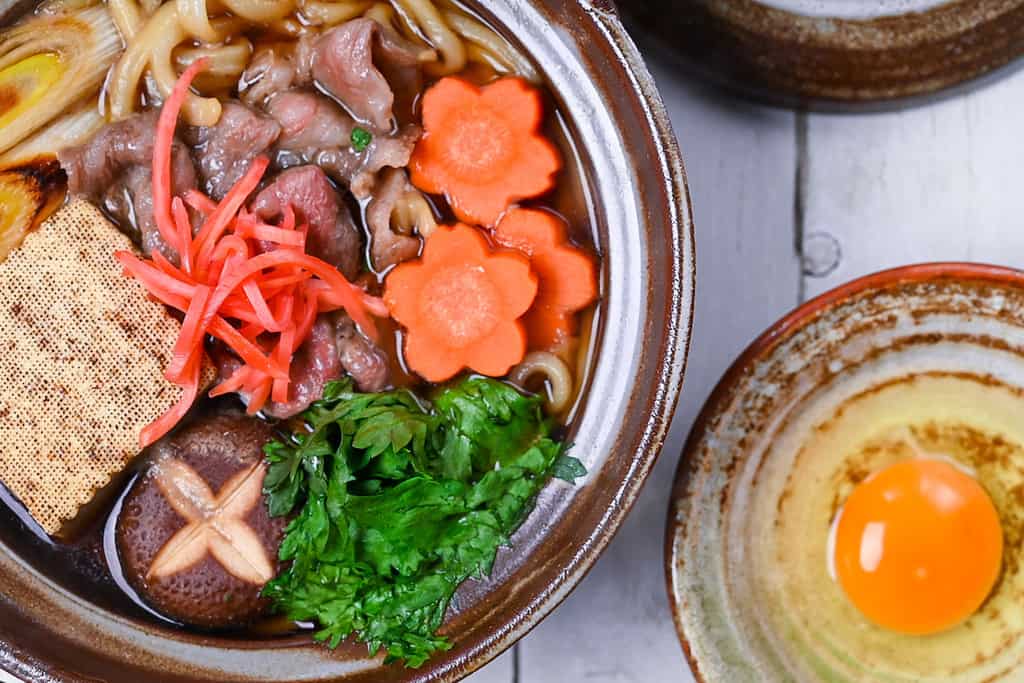
Suitable Beef Cuts to Use
Sukiyaki is a fancy dish, and Japanese people usually eat it for celebrations and special occasions.
High-quality wagyu beef is often used for sukiyaki, and it’s always cut thin so that it’s quicker and easier to cook in the broth.
Let’s look at the different kinds of beef in more detail.
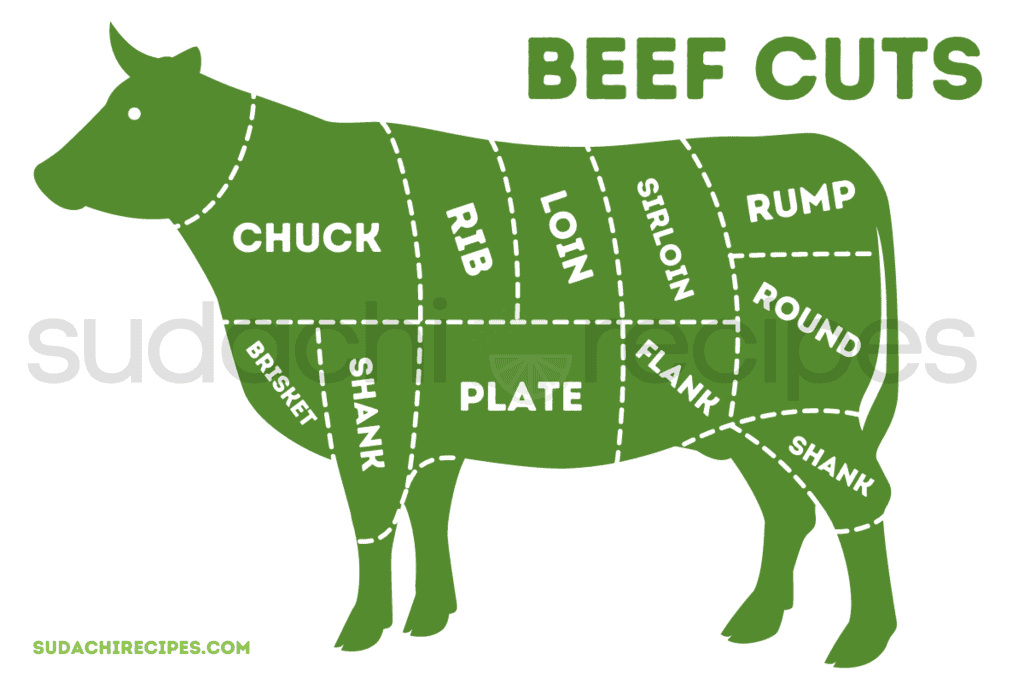
- Marbled: For sukiyaki, choose meat with lots of marbling and fat. This fat enhances the broth’s taste. Marbled beef becomes soft when cooked, while lean beef can become tough. Rib and loin cuts have the most marbling, while sirloin and round have less. Japanese wagyu beef is especially known for its extra marbling.
- Plate: Plate is budget-friendly, making it great for sukiyaki udon. It’s known for its tasty flavor and works well in yakiniku and gyudon. But, cook it briefly; overcooking can make it tough and bland.
- Round: Round is a leaner choice with minimal fat, making it tricky for sukiyaki since it can get tough when overcooked. It’s a good pick for those who want to avoid fatty cuts.
- Chuck: This meat is tender with a fine texture, rich flavor, and good marbling. It’s versatile, suitable for thin slices in shabu shabu, sukiyaki, and yakiniku, or cubed for stews.
- Rib: Rib meat offers a balanced mix of lean and fat, delivering a rich taste. Its marbled cuts shine in sukiyaki. It’s arguably the beef’s tastiest and most luxurious choice of all.
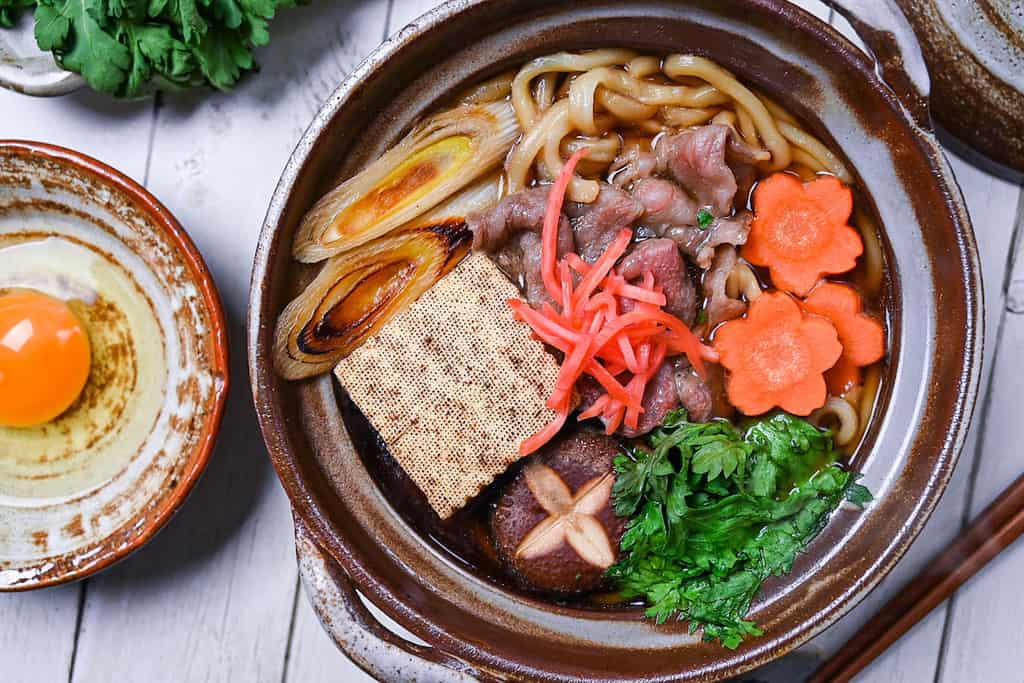
Ingredients & Substitution Ideas
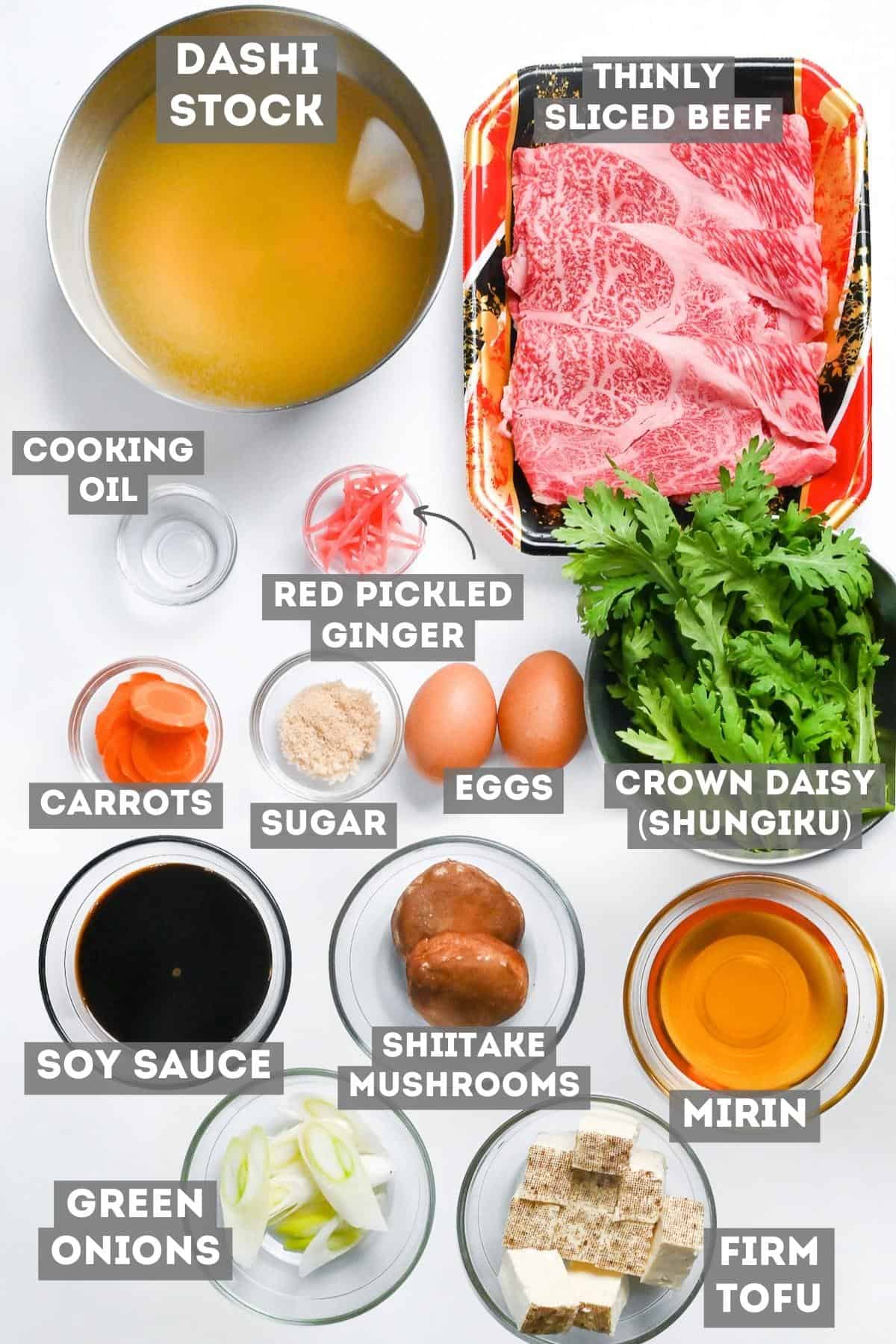
- Thinly Sliced Beef: Just choose your favorite cut from the list we’ve put together in the section above.
- Udon Noodles: You can choose from pre-boiled, frozen, or dried udon, and they all work great. If you’re feeling ambitious, why not give my homemade udon recipe a try for an extra special touch!
- Dashi Stock: If you want to get the full authentic experience, I recommend trying my go-to simple awase dashi (made with kombu and bonito flakes). If you’re short on time, dashi packets are a handy alternative.
- Vegetables: I used Japanese leek (or regular leek), carrot, shiitake mushroom, and crown daisy (shungiku). If shiitake mushrooms aren’t available, other mushroom varieties will do. Likewise, shungiku can be replaced with alternatives like pak choi, watercress, spinach, or Napa cabbage.
- Soy Sauce: For more detailed brand recommendations, please check out my comprehensive soy sauce guide on the blog.
- Mirin: If you can, go for “hon mirin” (本みりん).
- Sugar: I like light brown cane sugar for its subtle molasses notes, but any granulated sugar will work well in this recipe.
- Yaki Tofu: The lightly grilled and charred tofu adds a smoky flavor to the dish. If you can’t find it, use firm or extra-firm tofu and quickly pan-sear it to get a similar effect.
- Toppings: A sprinkle of red pickled ginger (beni shoga) adds a tangy, vibrant kick.
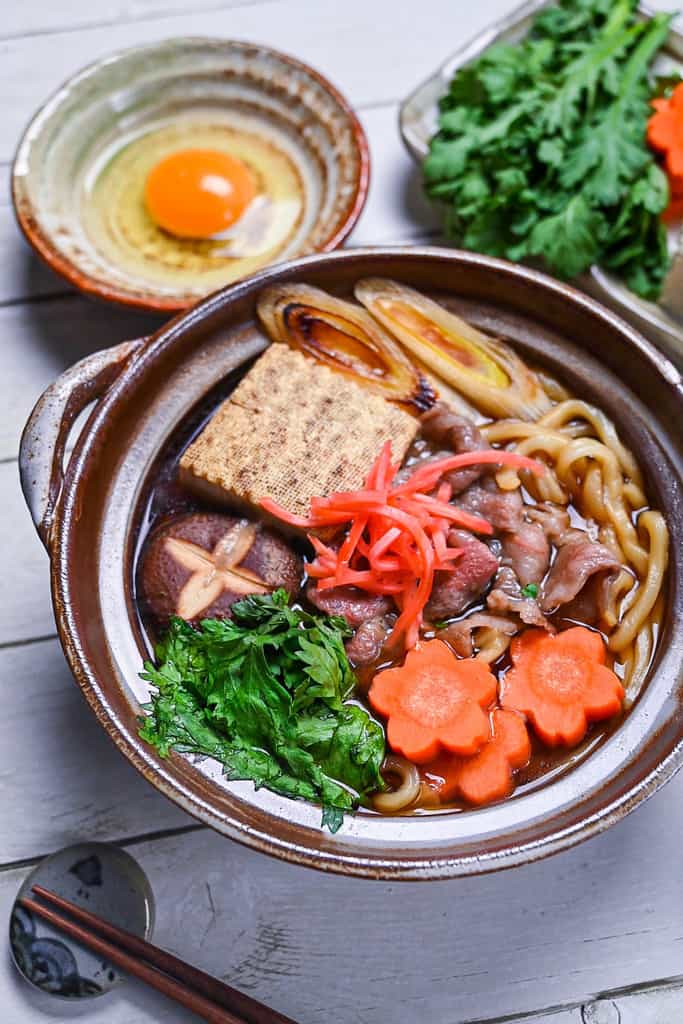
Visual Walkthrough & Tips
Here are my step-by-step instructions for how to make Beef Sukiyaki Nabe Udon at home. For ingredient quantities and simplified instructions, scroll down for the Printable Recipe Card below.
If you prefer to watch the process in action, check out my YouTube video of this recipe for a complete visual walkthrough!
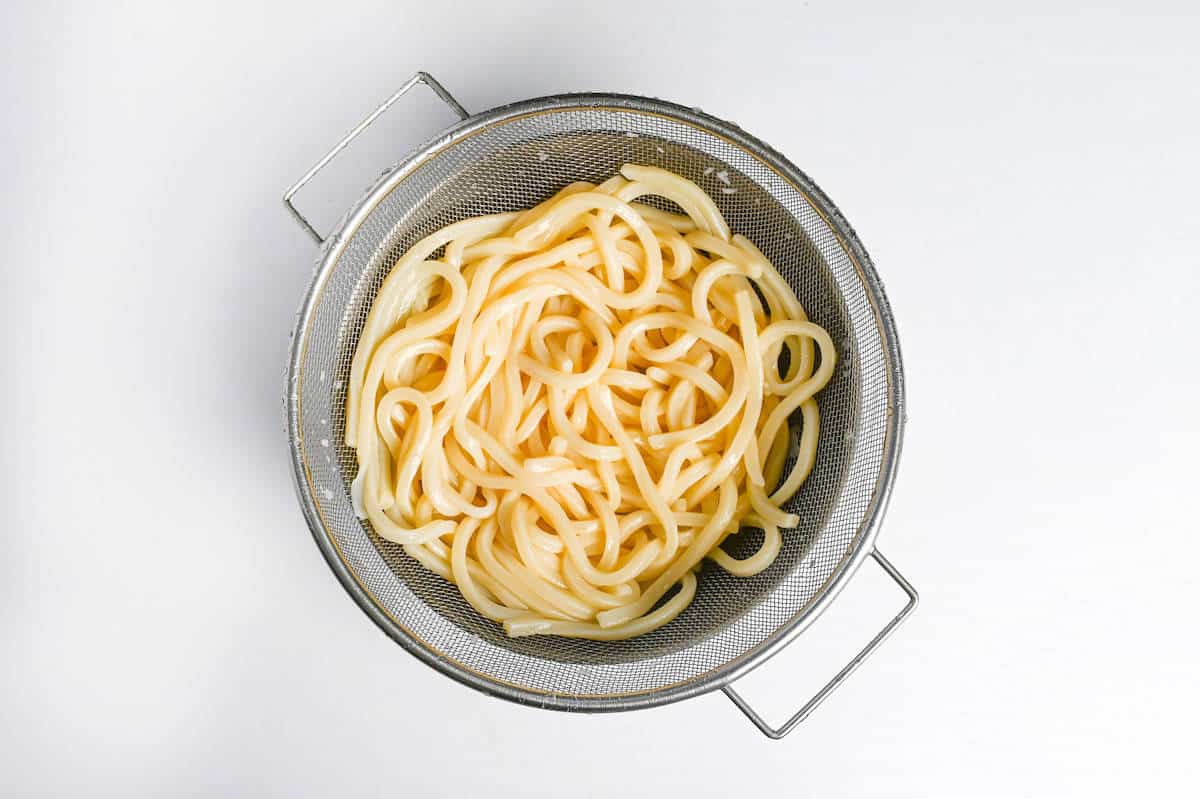
If you cook the udon noodles directly in the broth, your broth can become thick and starchy. Pre-boiling the udon for 3-4 minutes less than the time stated on the packaging will remove the excess starch without overcooking them. Once parboiled, drain them in a colander and rinse with fresh water.
Some brands sell udon noodles that already have a cooking time of less than 3-4 minutes (often pre-boiled). In this case, wash them with hot water before adding them to the broth. If using frozen, I recommend blanching them in boiling water for about 30-60 seconds before adding them to the broth.
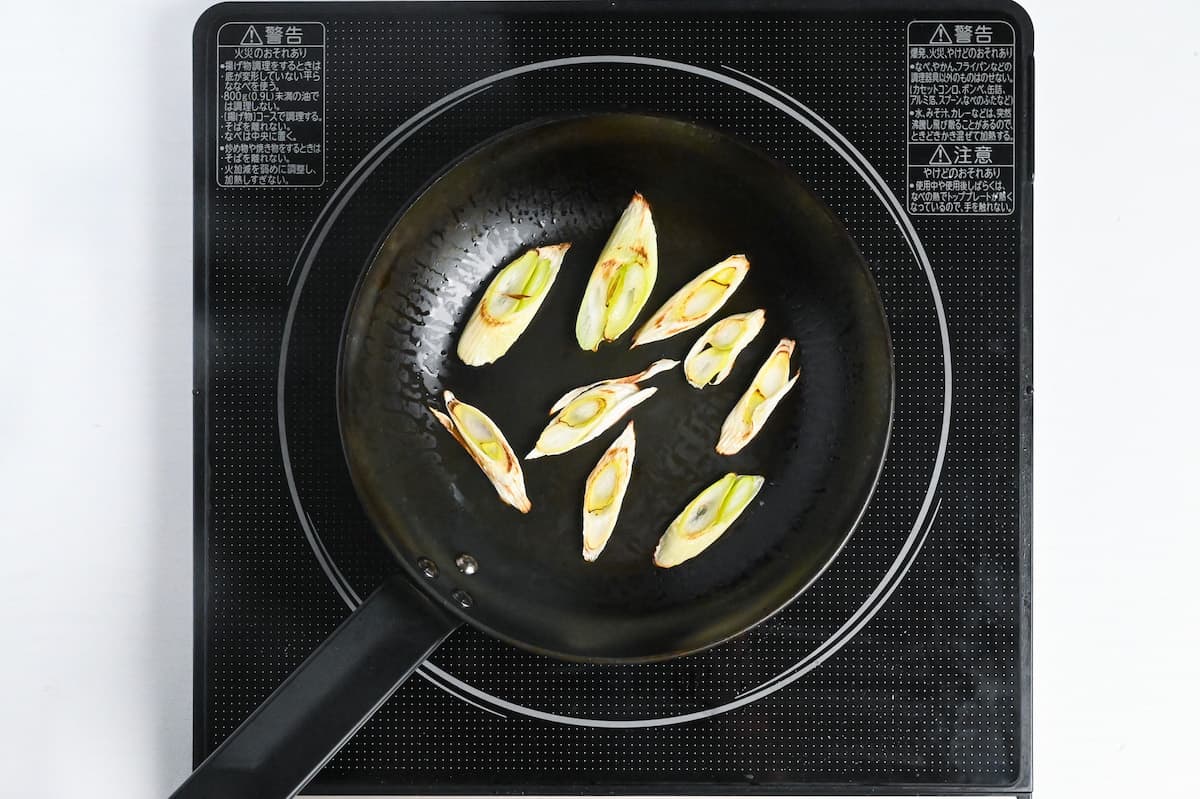
Diagonally cut the green onion into thin slices and fry in a pan with a little oil (or beef fat) until lightly charred. Once charred, remove from the heat and set aside.
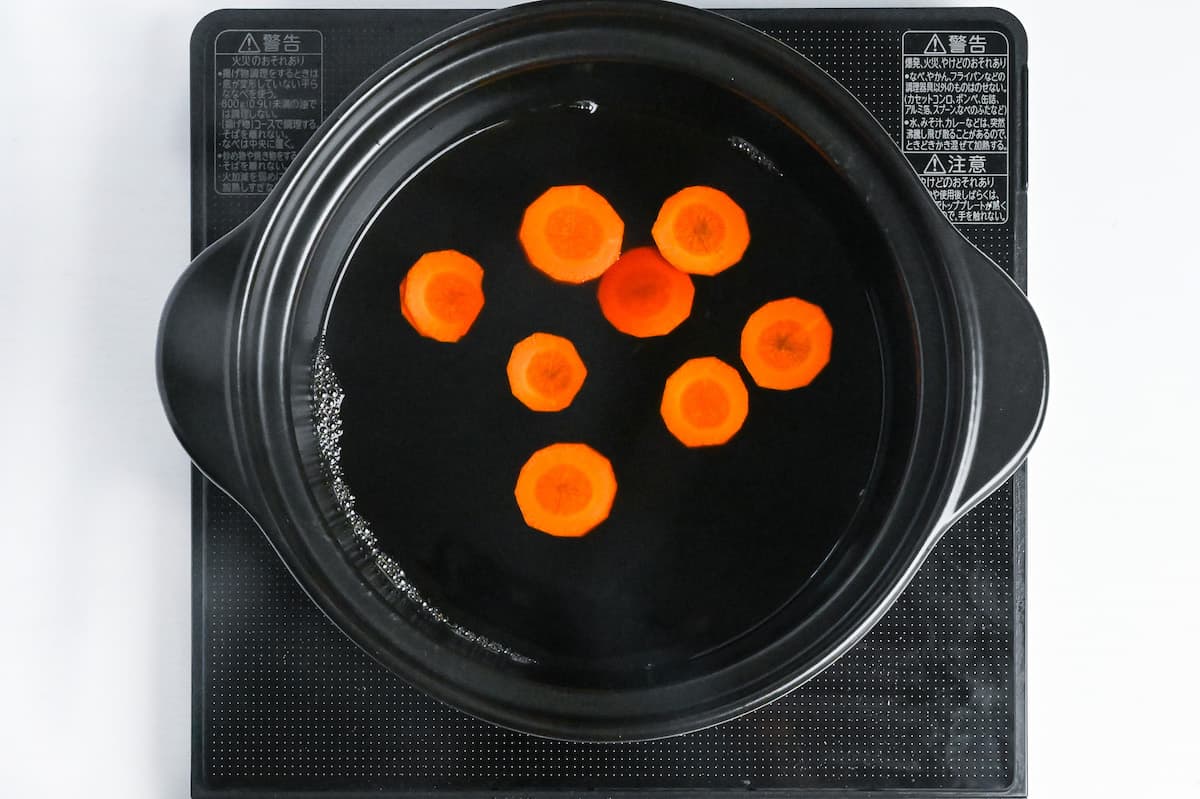
Take a pot (or donabe) and add dashi stock, soy sauce, mirin and brown sugar. Since carrots take the longest to cook, add them now and bring the broth to a boil. If you’re adding other root vegetables, you can add them together with the carrots.
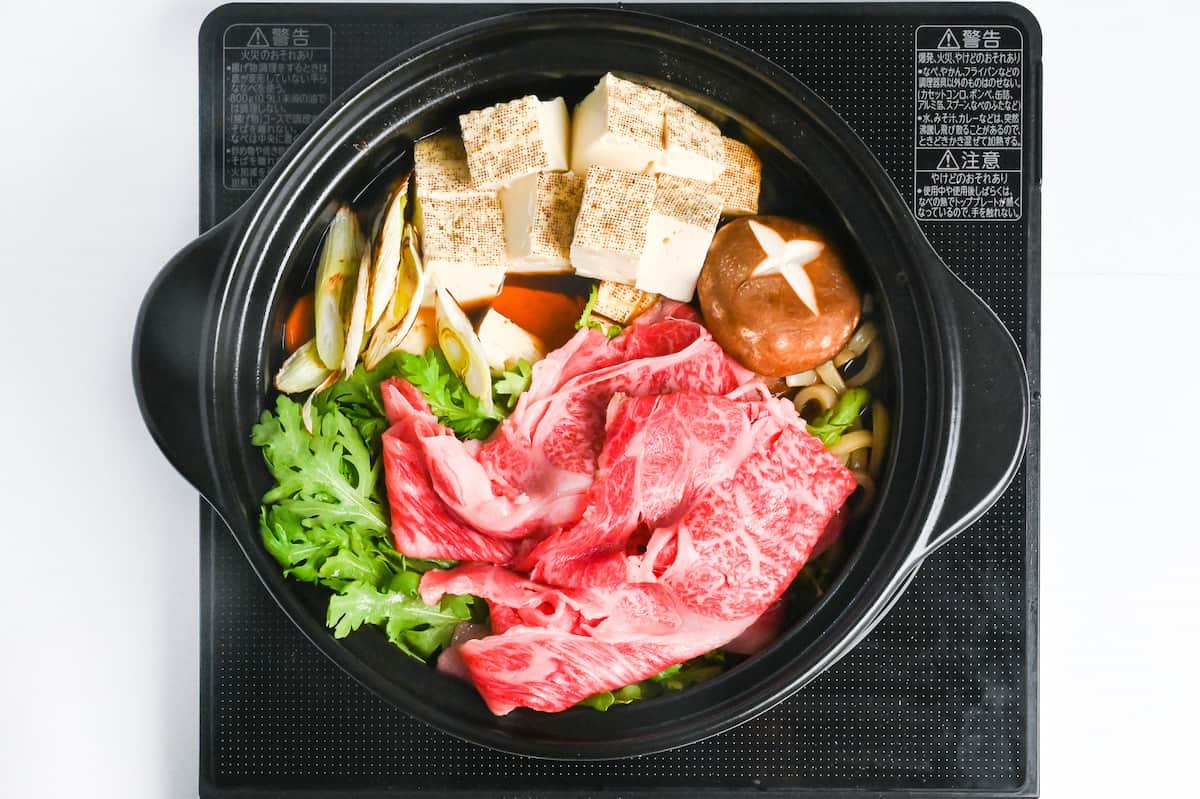
Once the carrots are slightly softened, add the prepared udon and charred green onions from earlier. Add the rest of the vegetables, tofu, and meat, and place a lid on top.
Cook for 3 minutes over a medium heat.
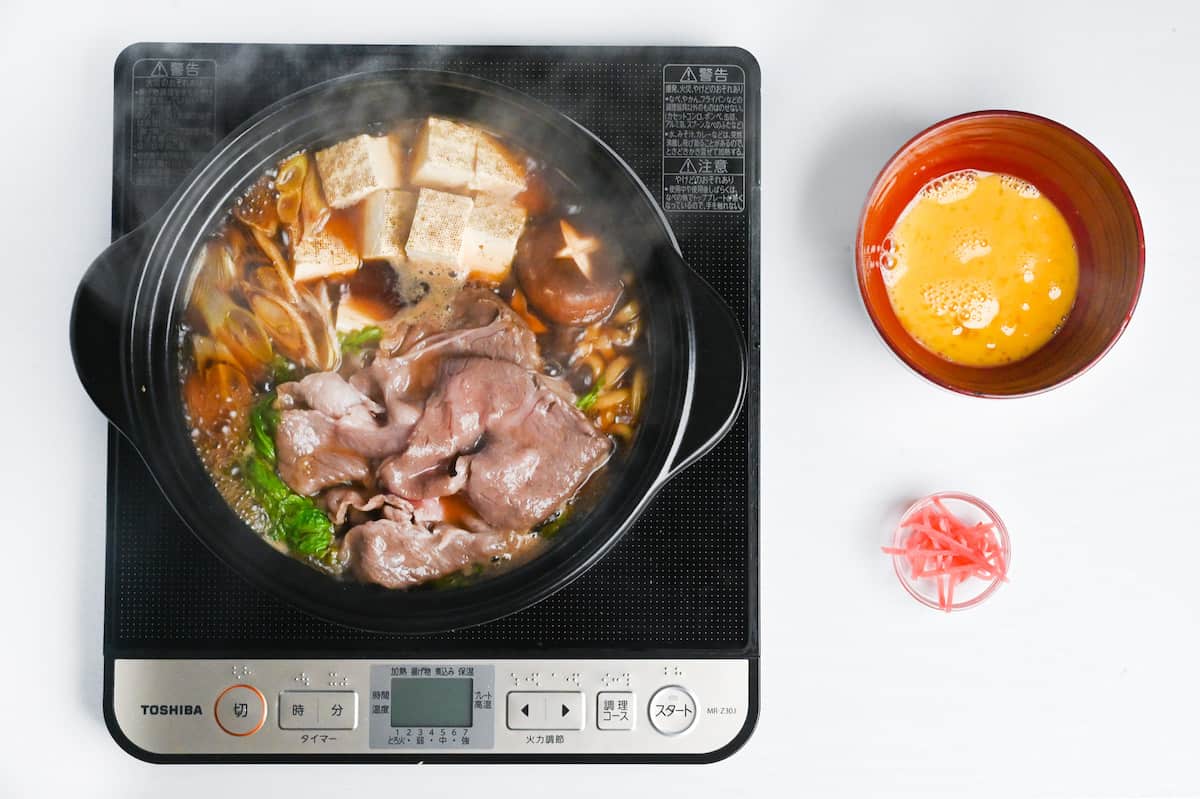
Enjoy beef sukiyaki udon straight from the pot or divide it into individual portions. If you eat it in true Japanese style, serve each portion with a raw whisked egg (pasteurized) for dipping and add a pinch of red pickled ginger (benishoga) on top.
Enjoy!
Jump to Full Recipe Measurements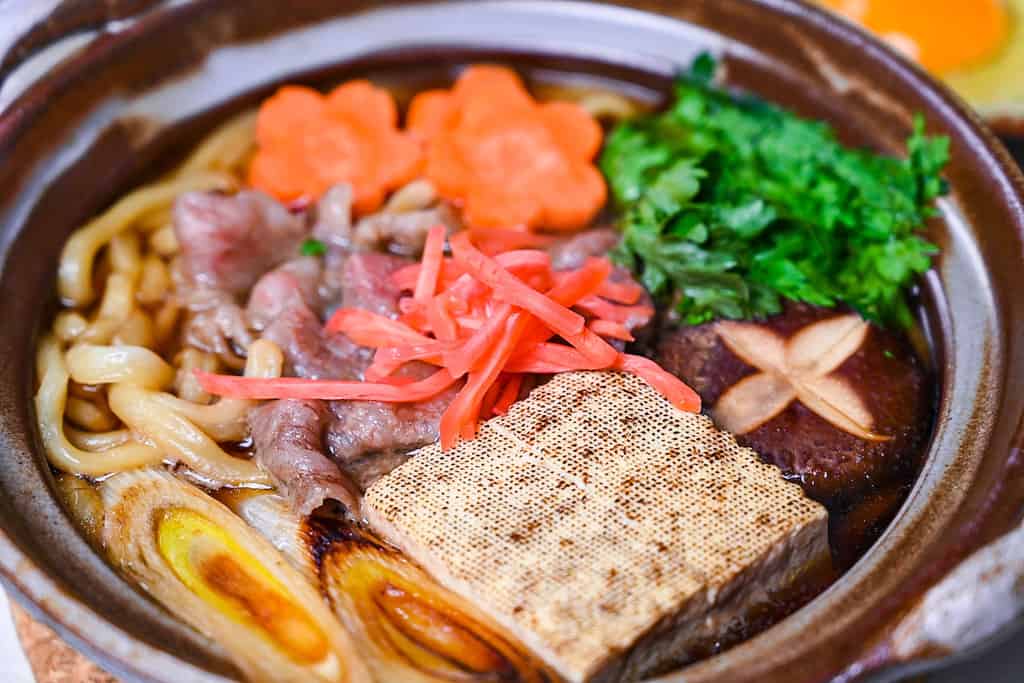
How to Store
Sukiyaki Nabe Udon is not suitable for storing leftovers. However, you can repurpose any leftover soup to make the dish again.
To store the soup, strain it through a colander to remove any leftover ingredients and then store it in an airtight container, whether refrigerated or frozen. You can refrigerate it for 2-3 days or freeze it for up to 2 weeks.
Storage summary (broth only)
Room temperature – Not recommended.
Refrigerated – 2-3 days.
Frozen – Up to 2 weeks.
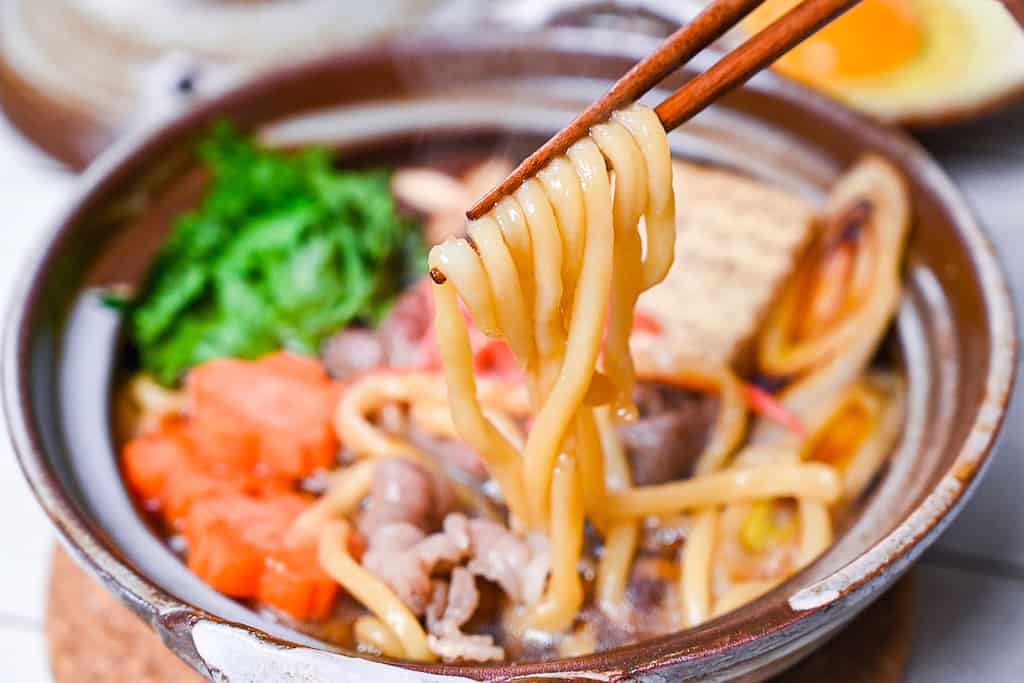
I hope you enjoy this Beef Sukiyaki Udon recipe! If you try it out, I’d really appreciate it if you could spare a moment to let me know what you thought by giving a review and star rating in the comments below. It’s also helpful to share any adjustments you made to the recipe with our other readers. Thank you!
More Japanese Udon Recipes
- Beef Niku Udon
- Chicken Nabeyaki Udon
- Chicken Udon Noodle Soup (Tori Nanban Udon)
- Japanese Curry Udon
Want more inspiration? Explore my Udon Roundup Post for a carefully selected collection of tasty udon recipe ideas to spark your next meal!
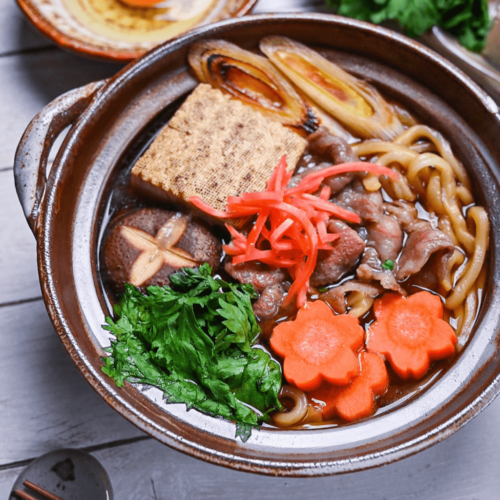
Beef Sukiyaki Nabe Udon
Ingredients
- 2 portions udon noodles
- 30 g Japanese leek (naganegi) white part, diagonally sliced
- 1 tsp cooking oil or beef fat
- 500 ml dashi stock
- 75 ml Japanese soy sauce (koikuchi shoyu)
- 75 ml mirin
- 1 tbsp light brown sugar
- 30 g carrot peeled and cut into rounds
- 2 fresh shiitake mushroom stems trimmed
- 50 g chrysanthemum greens (shungiku) shungiku, see in post for alternatives
- 150 g thinly sliced beef see in post for best parts to use
- 150 g firm tofu momen tofu, cubed
- 1 tsp red pickled ginger (benishoga) optional garnish
- 2 eggs pasteurized, optional for dipping
My recommended brands of ingredients and seasonings can be found in my Japanese pantry guide.
Can’t find certain Japanese ingredients? See my substitution guide here.
Instructions
- First, blanch/parboil 2 portions udon noodles. If using dry udon, boil them for 3-4 minutes less than the time stated on the packaging. Pour the noodles into a colander to drain and rinse with fresh water to remove any excess starch.

- Cut 30 g Japanese leek (naganegi) into diagonal slices. Heat a small frying pan and add 1 tsp cooking oil or beef fat. Add the leek slices and lightly char on both sides. Once charred, remove from the heat, and set aside.

- Place your cooking pot on the stove and add 500 ml dashi stock, 75 ml Japanese soy sauce (koikuchi shoyu), 75 ml mirin and 1 tbsp light brown sugar. Add 30 g carrot to the pot and bring the broth to a boil. Let it bubble gently for 1-2 minutes.

- Add all of the other ingredients (charred leek from earlier, 150 g thinly sliced beef, 2 fresh shiitake mushroom, 50 g chrysanthemum greens (shungiku), 150 g firm tofu and the parboiled udon) and cover with a lid. Cook for 3 minutes over a medium heat.

- Enjoy straight from the pot or divide into portions. Each serving can be served with 1 tsp red pickled ginger (benishoga) (benishoga) and a raw whisked egg for dipping (optional).

- Enjoy!
Video
Notes
- This recipe can be made in one large pot and shared, or divided into two individual serving pots.
- Extra ingredients can be cooked in the leftover broth.
- Note: While the nutritional information includes the full serving of broth, most people in Japan don’t actually finish all the soup.
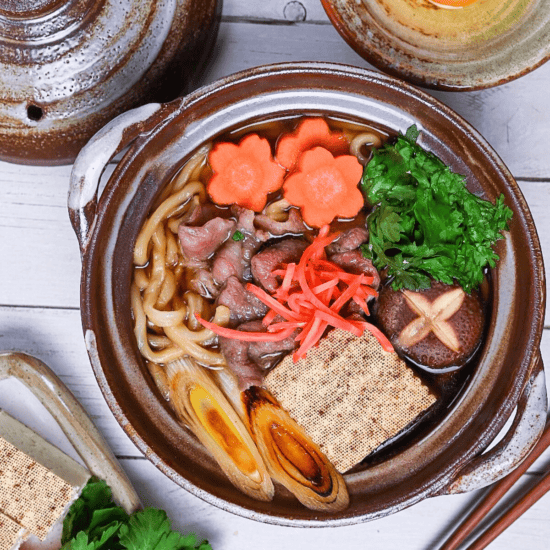




Love this recipe. I have made it twice. Used bok choy as that’s what I had already but I can access shungiku so will try that next. I used a beef steak I finely sliced first and that was great. The next time I used “chime sal” cut from a Korean Australian butcher. I think it is US plate. It was okay not great, but that’s on me. It was cut thicker to bbq. But overall I really love how tasty and easy this is. Thanks.
Hi Jane,
Thank you for trying the recipe and your kind words, glad you enjoyed it!
Shungiku is quite a typical ingredient to add in Japan but I think bok choy is a great substitute!
Choosing the right meat for this dish can be a bit tricky and thinly sliced works best. Thanks again for all your feedback!